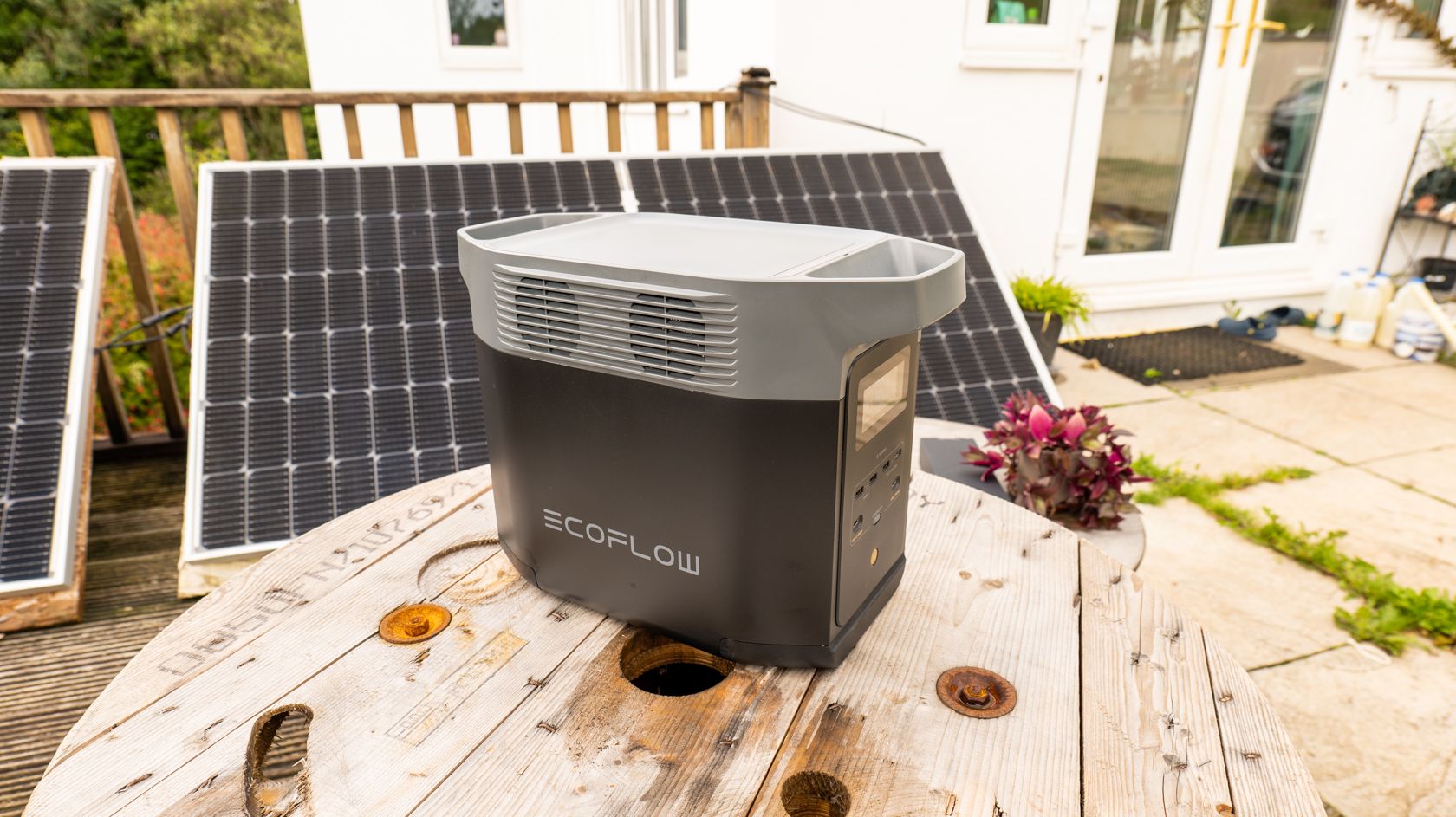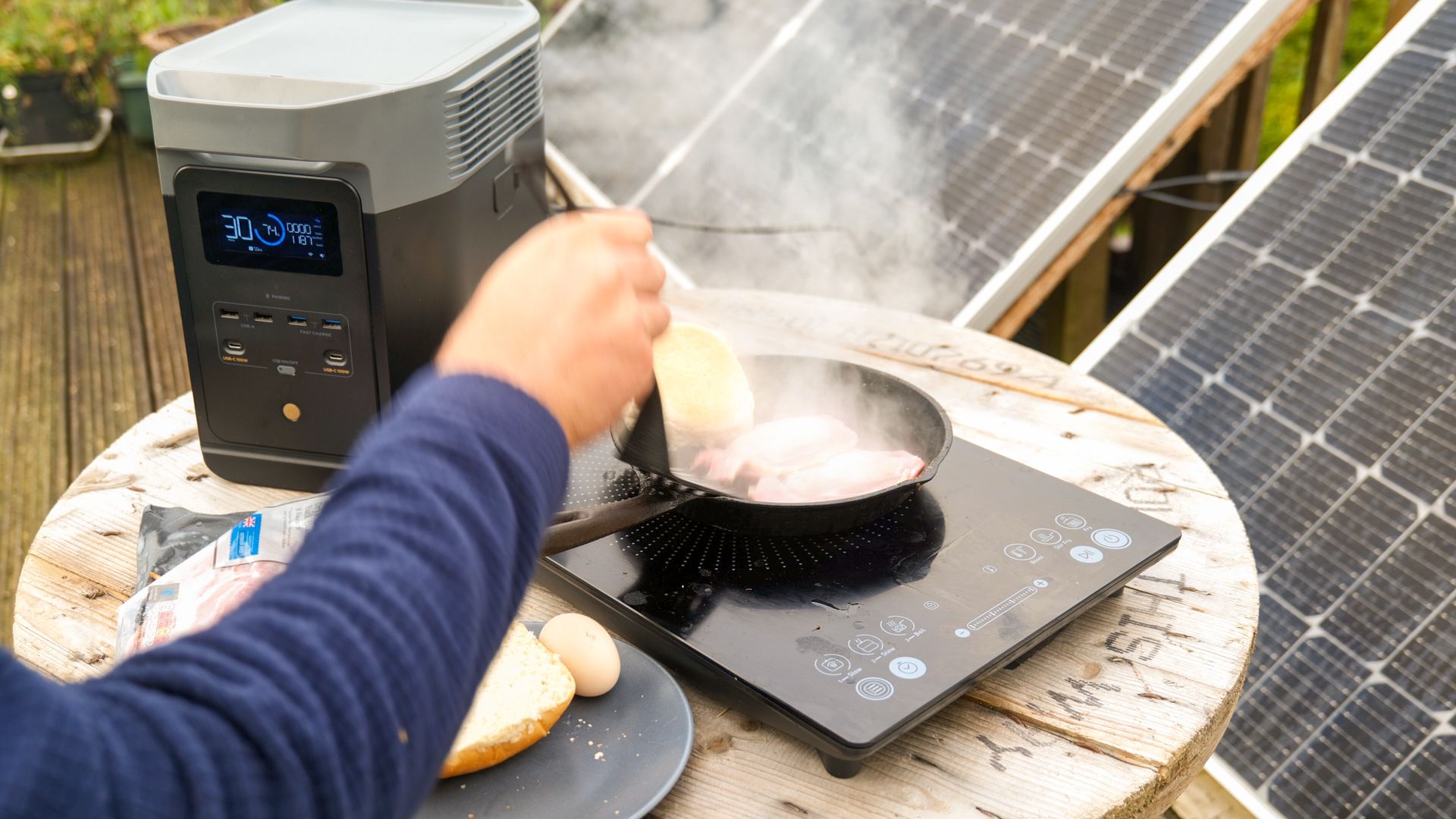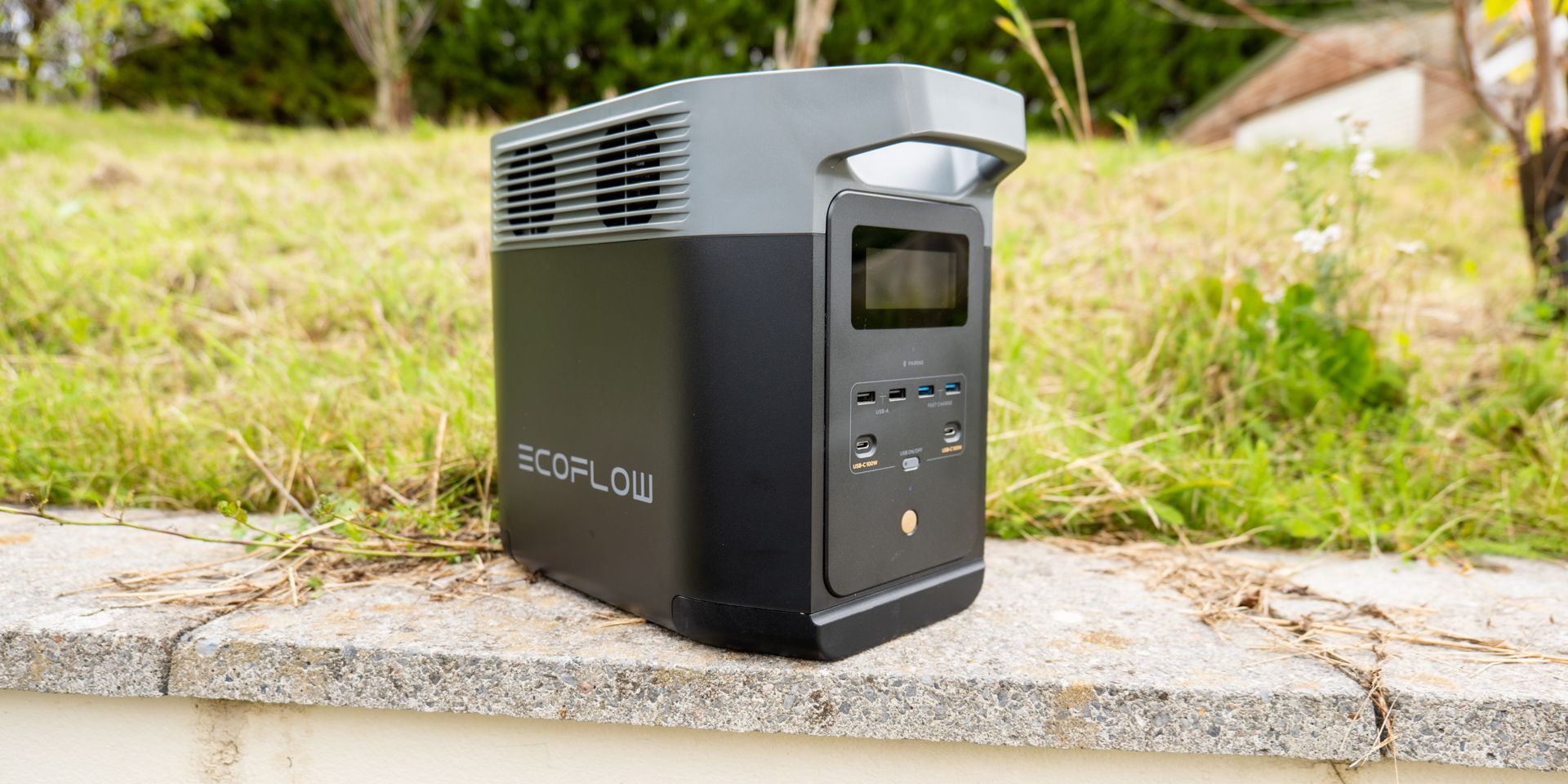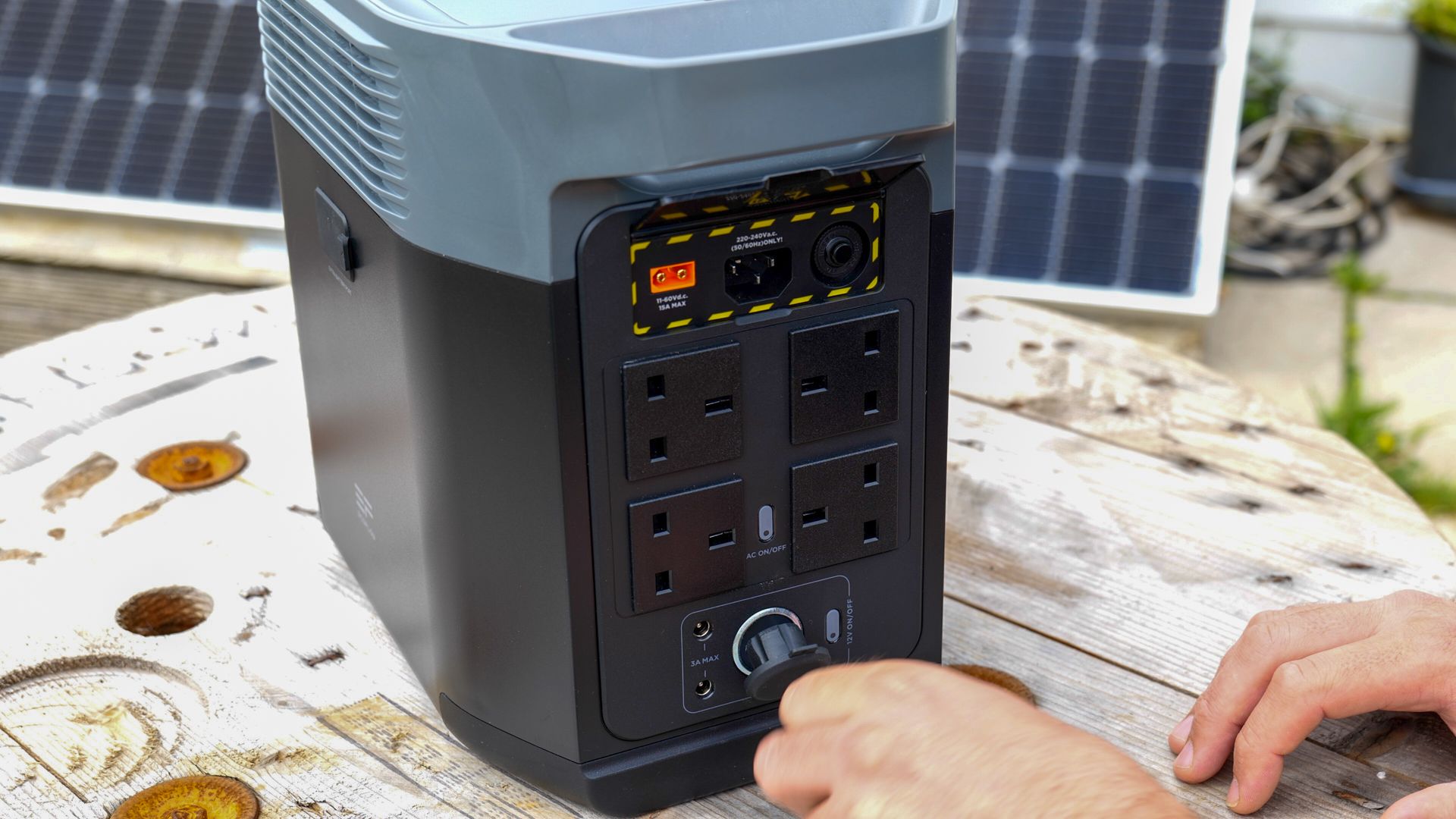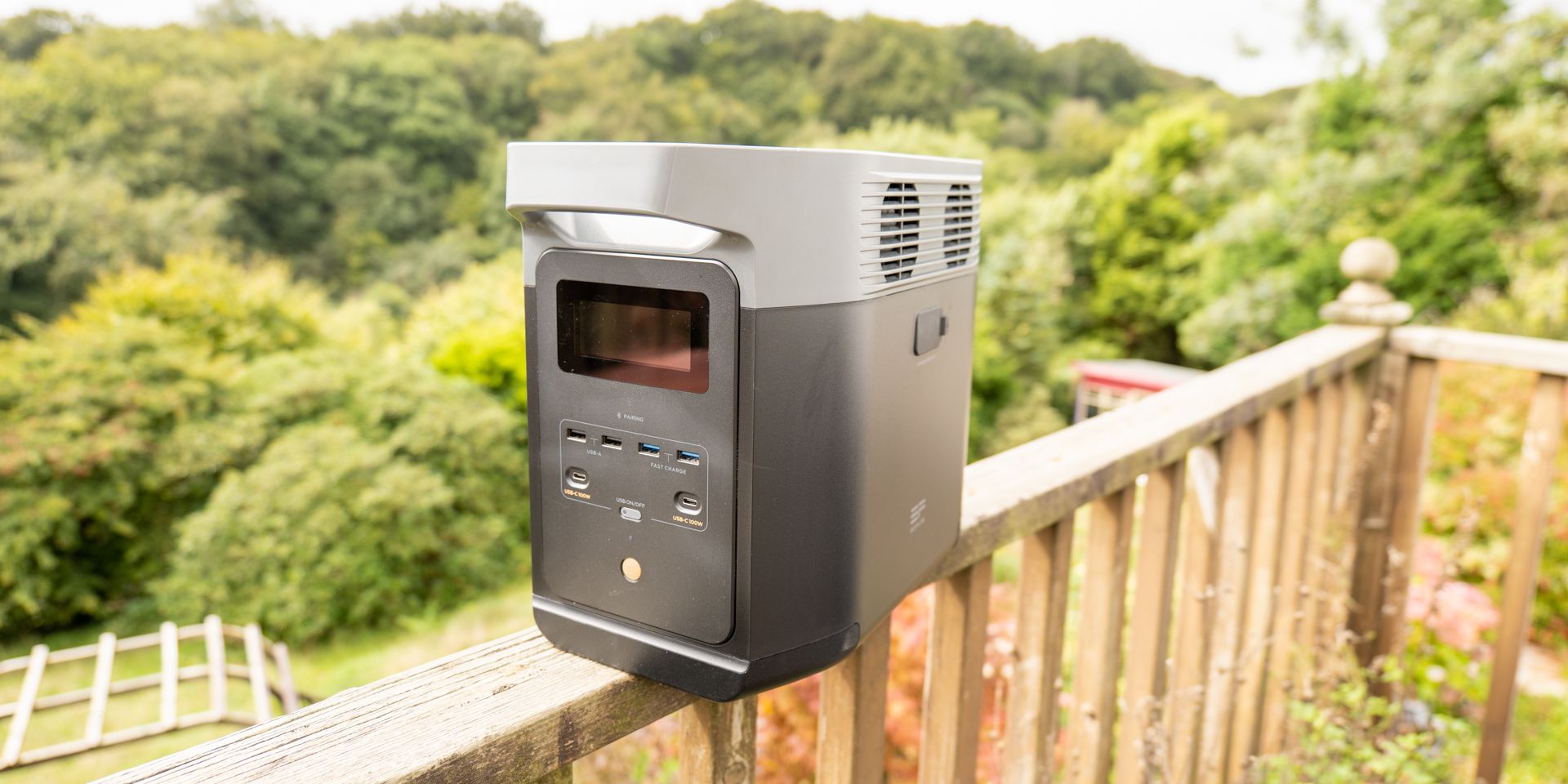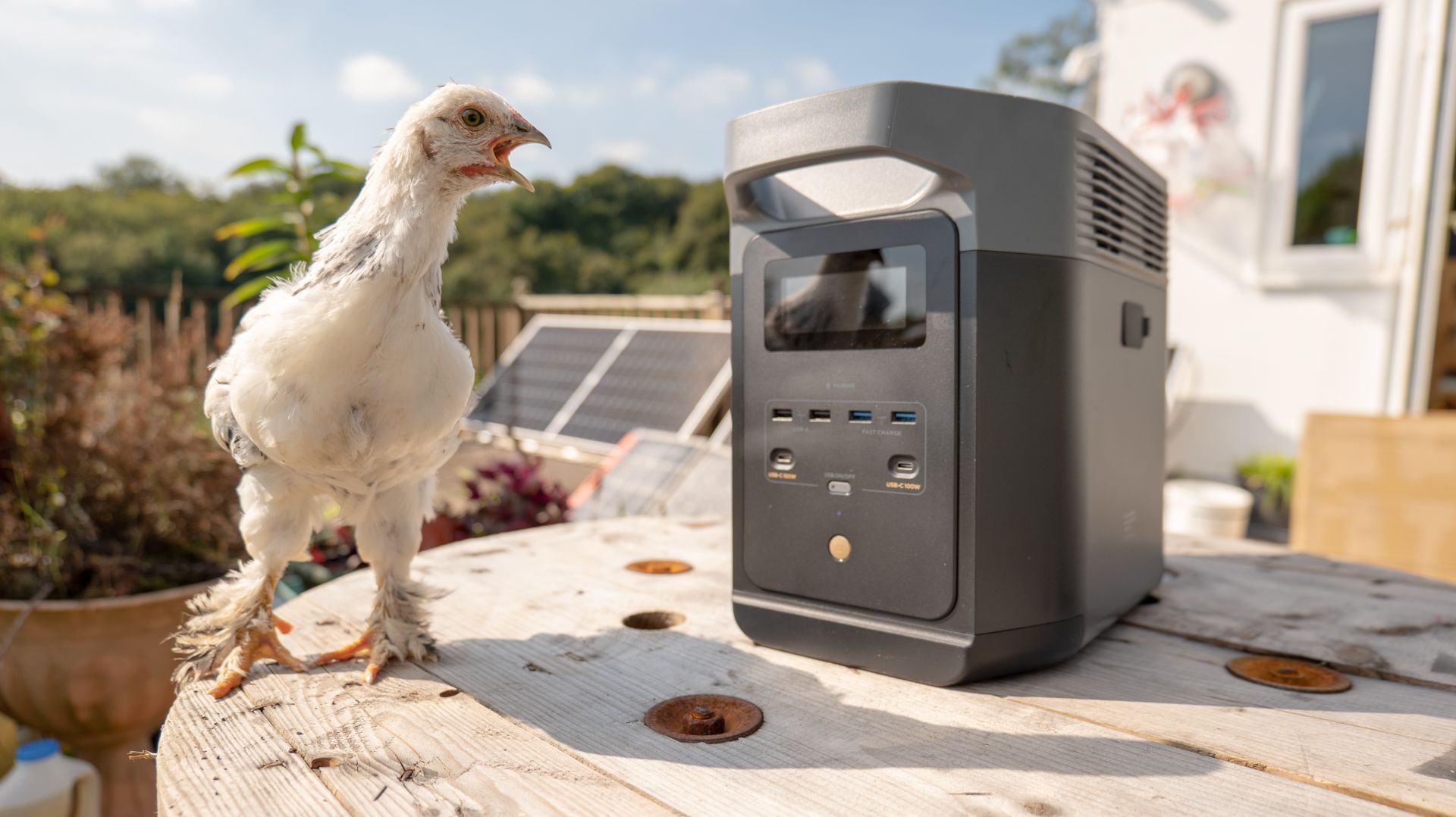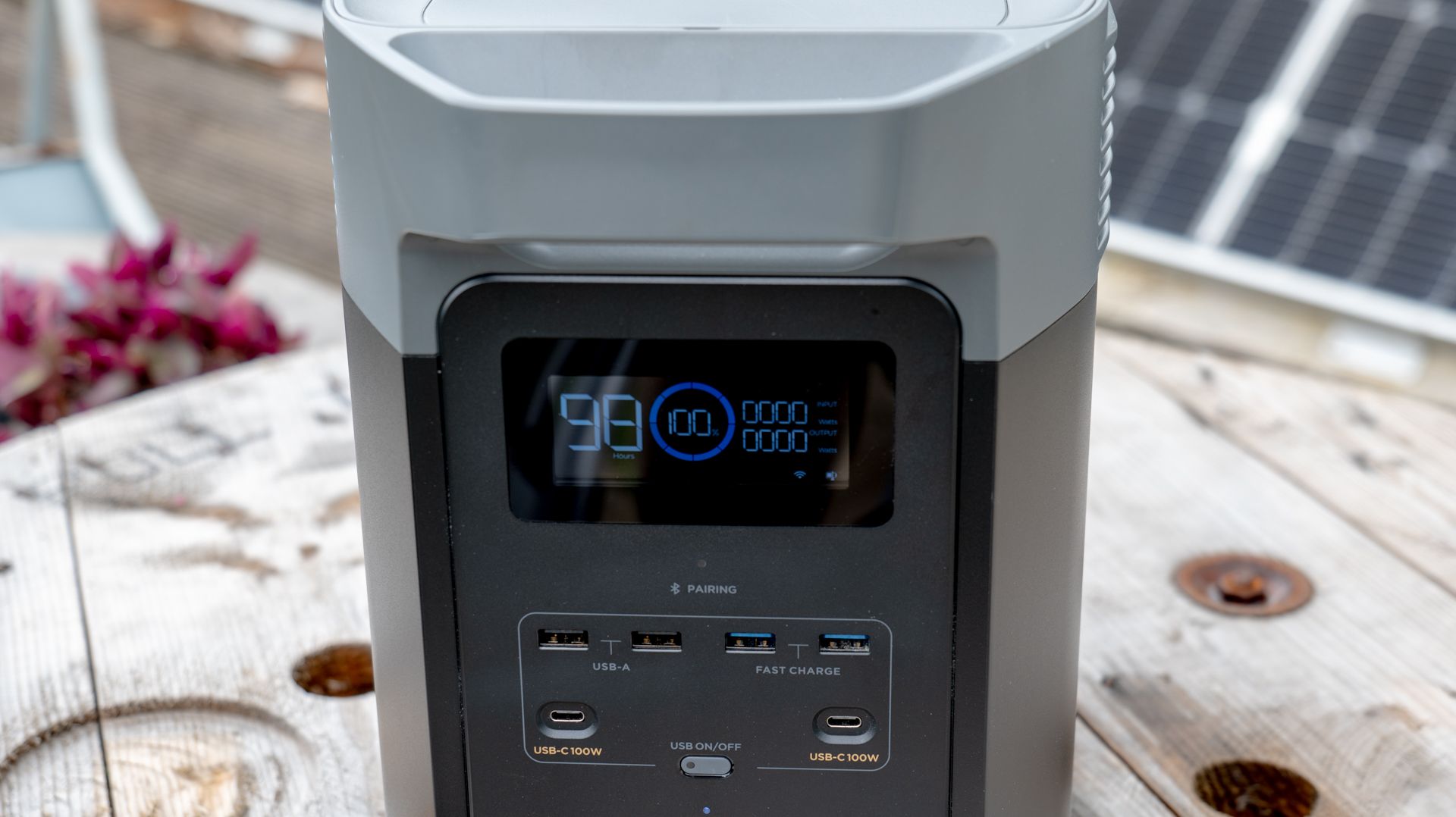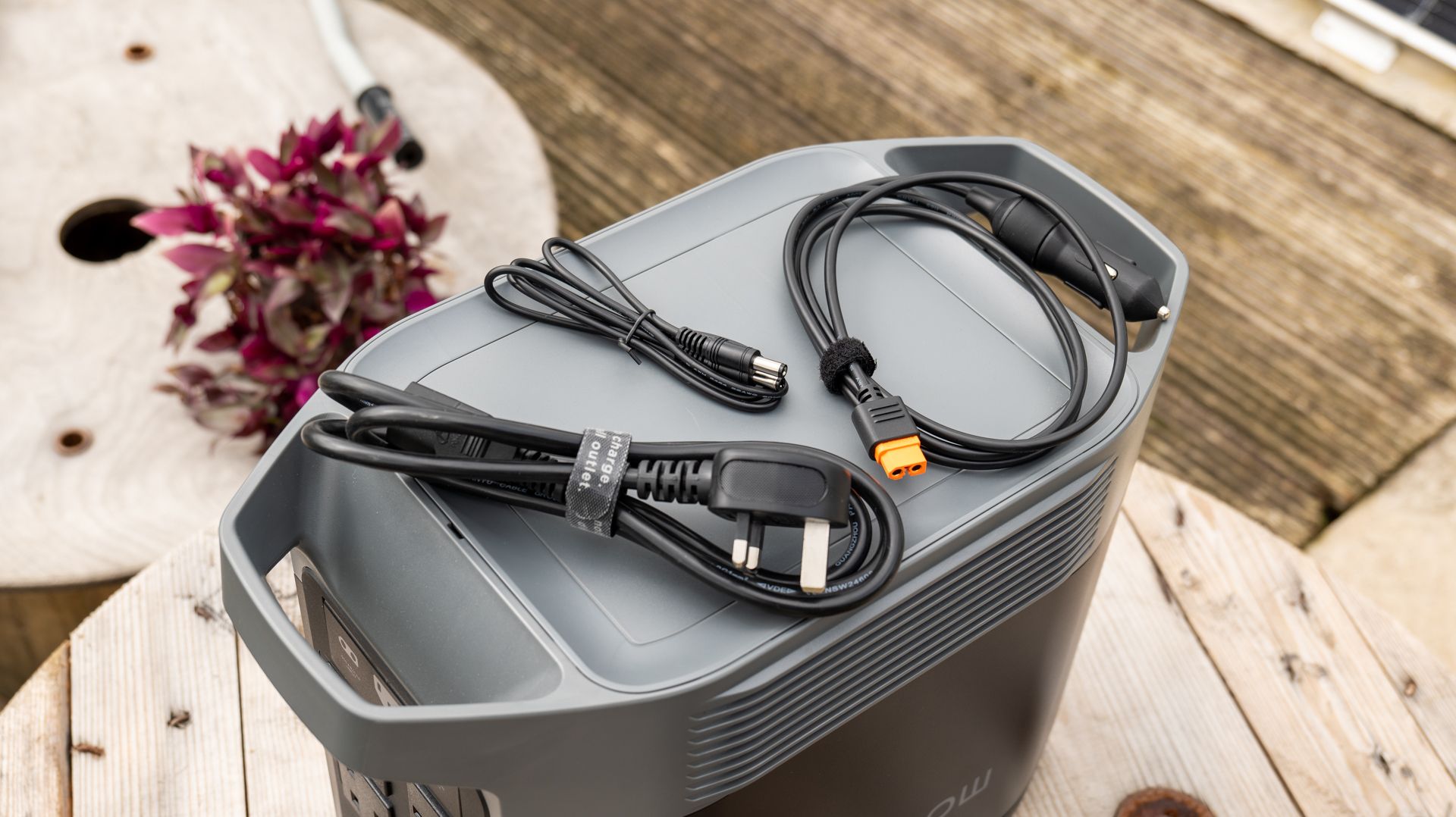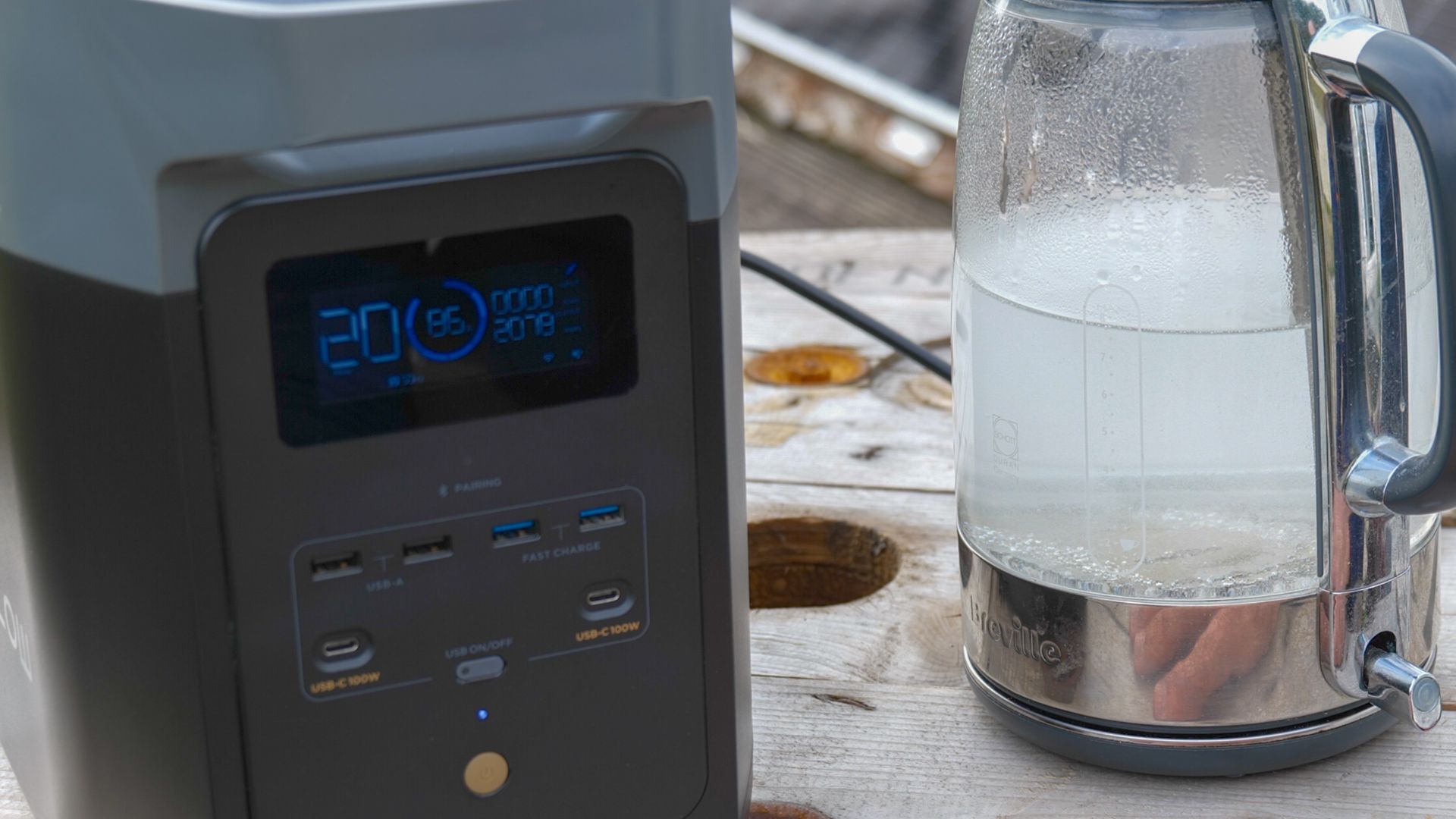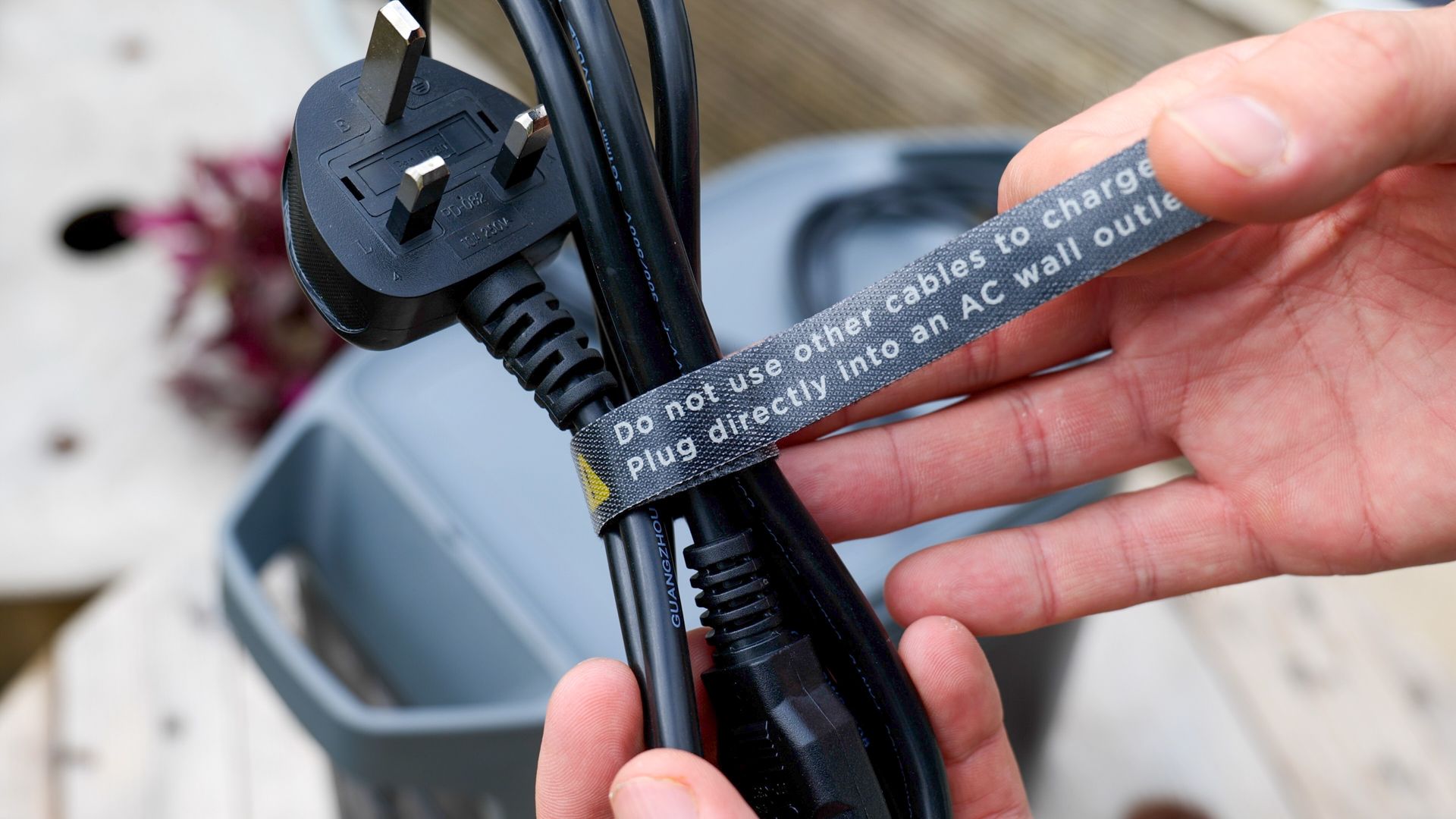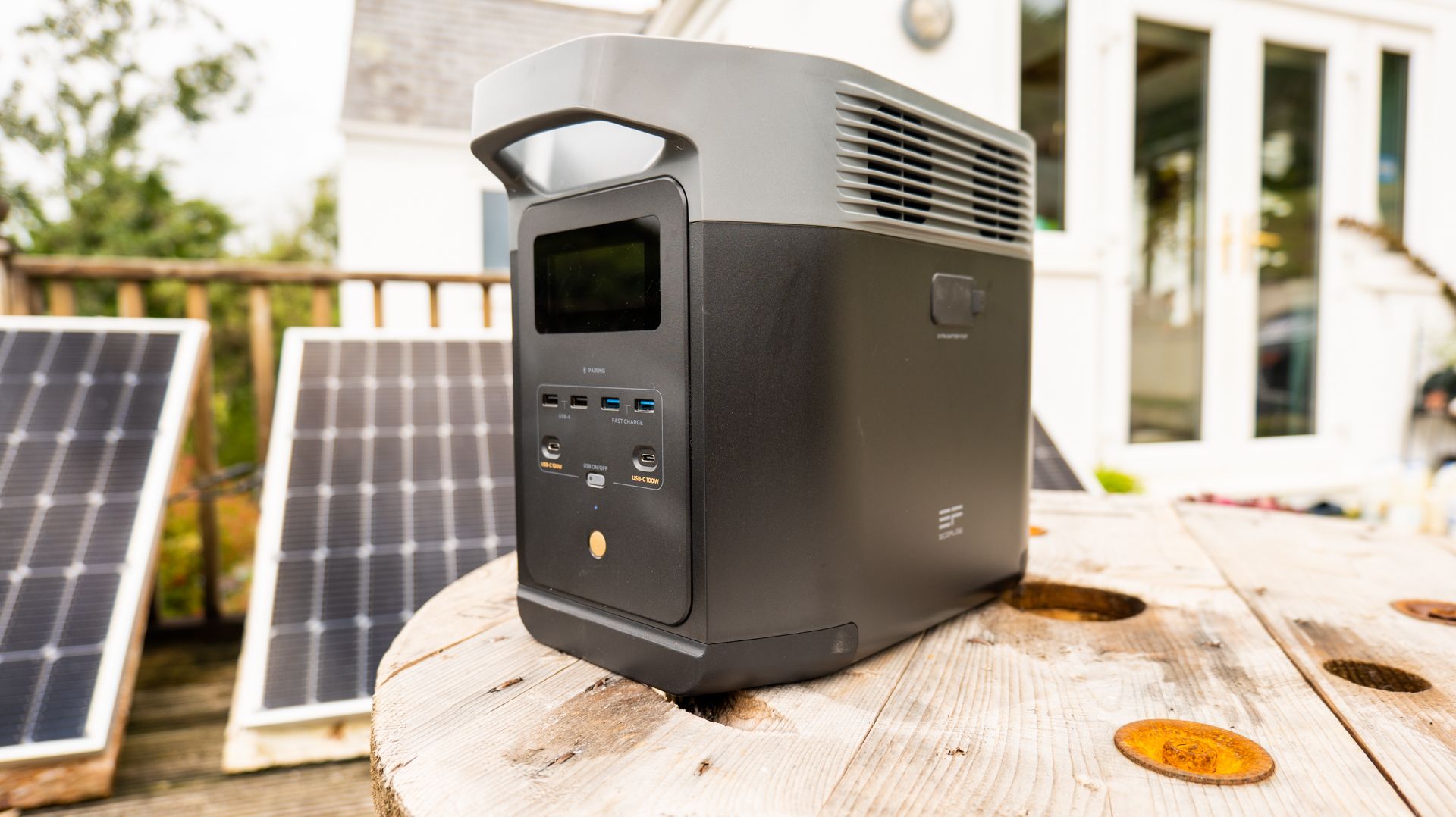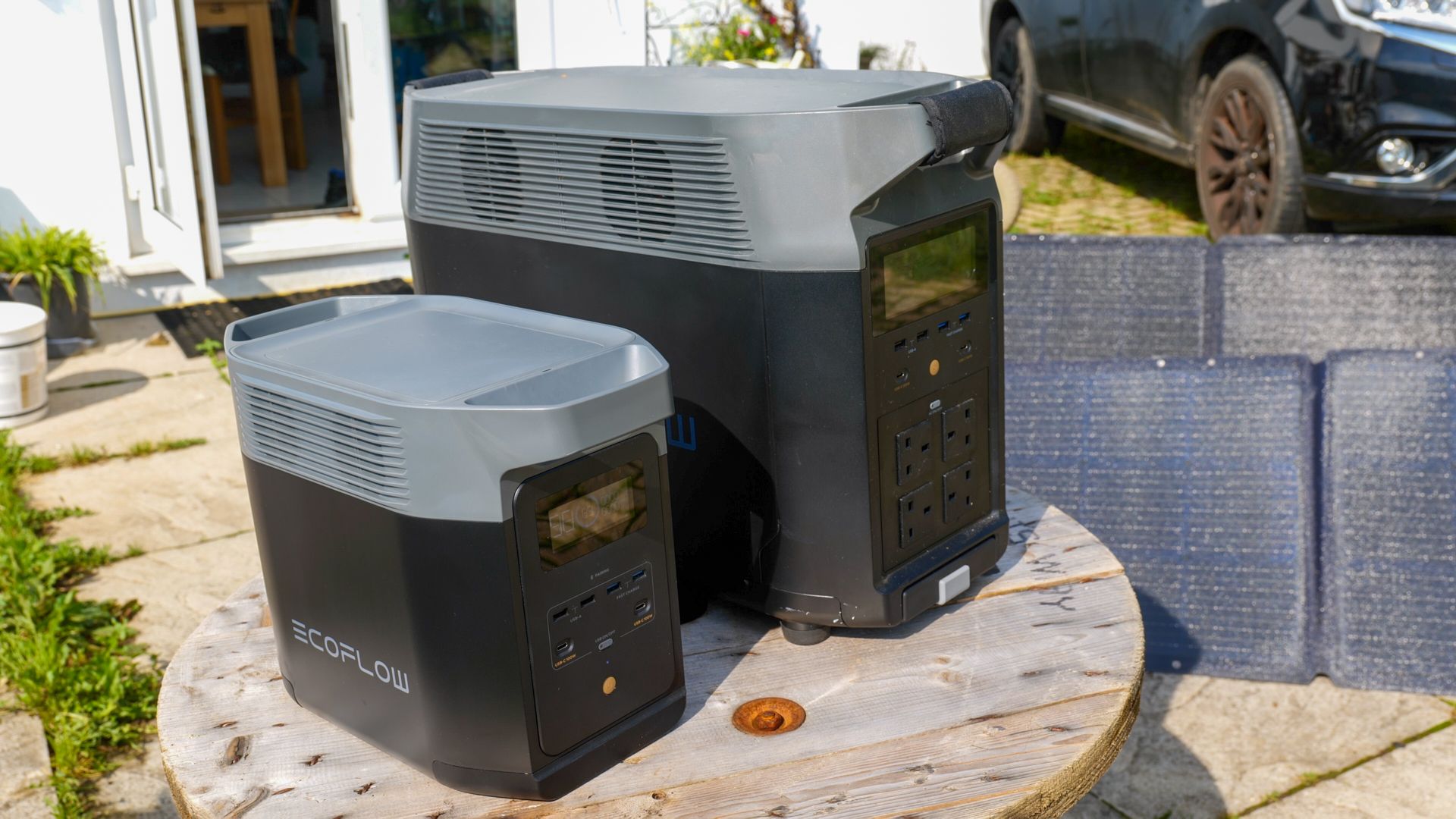Ecoflow Delta 2
The Delta 2 is a mid-capacity portable power station with seriously high output potential, for those with high power needs on the go. It lacks other convenience features you might want when camping, such as an LED light or wireless charger, but if you want your battery to be the best battery it can be and nothing else, this is for you. Though the price is in line with competitors, the superior 3000 cycle rating makes it a better overall buy.
- Brand: Ecoflow
- Weight: 12kg (27lbs)
- Size: 400 × 211 × 281mm (15.7 × 8.3 × 11.1 inches)
- Capacity: 1024Wh
- Maximum Discharge: 1800W (2700W surge)
- Solar Controller: MPPT
- Output: 4 x AC sockets, 2 X USB-A, 2 USB-A fast charge, 2 x USB-C PD 100W, 12V car port, 2 x 12V DC sockets
- Input: 500W solar, or 1200W AC (80 minutes to full)
- Lifecycles: 3000 cycles to 80% capacity
- Genuinely portable
- Huge discharge potential proportionate to capacity
- Reliable smartphone app
- Only 500W solar input
- No camping light or wireless charging
The Delta 2 is Ecoflow's latest portable medium-capacity expandable smart backup battery, and there are three main features I think make it stand out in a crowded market.
What Makes the Delta 2 Different?
High output compared to capacity. Despite being a mid-capacity 1000Wh battery, the 1800W continuous output combined with Xboost mode means it's able to power all but the most powerful of household appliances. If you need to, you can fully deplete a full battery in half an hour!
LFP battery technology. The Lithium Iron Phosphate cells are rated to 3000 cycles, which is well above the industry average. That means the battery is going to last for longer. If you're going to use it frequently, that should be a key consideration.
Smartphone app with Wi-Fi connectivity. Though the data presented from the Delta 2 is fairly simplistic (and certainly not as in-depth as the Delta Pro), the app is reliable, connects remotely over Wi-Fi, and just works. That's rare for a smartphone app, let alone in the world of backup batteries.
The Delta 2 will be available soon and it costs $999 (£/€1099)—which works out at just under $1 per watt-hour of storage. In addition, you can expand that capacity with either a basic extra battery of another 1024Wh, or a Delta max extra battery of 2016 Wh (but not both), bringing you to a total of 2 or 3kWh storage. Additional batteries are cheaper as they don't contain any of the complex inverter electronics, which bring the price per watt-hour even lower than $1.
Ecoflow Delta 2 Size and Specs
Measuring 400 × 211 × 281mm (15.7 × 8.3 × 11.1 inches), the Delta 2 weighs a mere 12kg (27lbs). It doesn't have wheels, nor does it need any—it should be easy enough for anyone to carry one-handed. You'll find a carry handle situated on both the front and back.
Around the front is the familiar and clear easy-to-read display panel showing the total input and output, battery remaining, as well as estimated charge or discharge time, and Wi-Fi connection status.
EcoFlow Delta 2 Output Capabilities
Underneath the display you’ll find plenty of USB ports:
- Two standard 5V 2A USB-A
- Two fast-charge USB-A
- Two 100W Power Delivery USB-C ports
Around the back is where you’ll find all the other ports—input, as well as AC ports. These will vary by country, but the UK model has four, situated fairly close together. Further under those, you’ll also find a 12V car port, plus two DC5521 ports. Only the car port is covered with a rubber protector bung.
The AC, DC, and USB port sections all feature their own power switches. If you're not using them, they should be deactivated to avoid trickling power unnecessarily to the inverter circuits.
So, what can you power with the Delta 2? Pretty much anything. Despite the mediocre 1024Wh capacity, the AC inverter is capable of providing a continuous 1800W total output (with 2700W surge), and that’s more than enough for most household appliances.
To demonstrate this, I used an induction hob to cook a nice bacon and egg bap outside (which was delicious, thank you) with a total power usage of around 1400W. You're not going to be able to plug in more than one high-power item, but check the ratings and as long as it doesn't exceed a total of 1800W, it's fine. This one breakfast used less than 10% of the power reserve.
For devices with a constant continuous draw, the time left indicator should reliably tell you how long the battery will last; either in hours if it's more than one, or minutes if it's less. But of course, you probably want to how long the battery will last before purchasing, in which case you can employ some basic math.
The capacity is 1000 Watt-hours, which means it can power a 1000 Watt device for 1 hour. You can just divide the capacity by the continuous draw of the device you want to power to find the number of hours it'll last. So a 50W CPAP machine (just an example, it could be anywhere between 30-100W in reality), will last 1000 (Wh) divided by 50 (W), or 20 hours.
If that's not long enough, also consider the additional batteries, which bring the total up to either 2000Wh or 3000Wh. However, you can't daisy-chain additional units, so 2 or 3kWh is the hard limit. At that point, you might prefer the Delta Pro, which has 3.6kWh of storage, and can be expanded even further.
What is Xboost Mode, and How Does It Work?
If you need to power something rated even higher (up to 2400W), you can enable Xboost mode using the app.
I mistakenly tried my electric kettle, which is actually rated to 3000W. But in the process of doing so, I learned how Xboost mode works, so I thought it worth sharing.
With Xboost mode enabled, the kettle overloaded the battery after about thirty seconds. But initially, I wasn't sure why. Both the app and LCD panel reported it was drawing only a little under 2100W. I reached out to Ecoflow support.
Of course, we quickly realized it was over the 2400W rated limit for Xboost; but still—why was it reporting only 2000W when that's clearly less than the 2400W? Was it under-reporting the actual power draw?
Apparently not. Xboost mode works—very cleverly, I think—by reducing the output voltage, while increasing the available current. Most high-power appliances such as hair dryers don't mind this at all. It just means they'll run a little slower than normal, or get a bit less hot. However, the total output power still can't exceed 1800W.
In my case, the kettle was undervolted in Xboost mode by about a third. Hence my 3000W-rated kettle was boiling more slowly than usual, and only drawing just over 2000W instead. But even that was still overloading the maximum 1800W of the inverter, and so the battery eventually shut down.
Without Xboost mode enabled, the kettle overloaded the battery immediately. Of course, because at its normal voltage, it was trying to pull the full 3000W.
The upshot is that you can run appliances that are rated up to 2400W—they’ll just run slightly slower or give off less heat.
Charging the Delta 2
There are three ways to charge the Delta 2:
- Solar (500W max, 11-60V@15A)
- Household AC (200W to 1200W configurable)
- Car charging (12V/24V@8A max)
For a battery of this size, 500W maximum solar charging is ample. Realistically that means it’ll take you around four hours to charge with a 400W panel (which is the highest you'll find in a portable panel), assuming decent conditions—or more likely all day in less than ideal scattered cloud.
If you have more than 400W-worth of solar panels, I think you're stretching the definition of portable and might want to consider a bigger battery.
However, while a car socket to XT60 cable is included, a suitable MC4 to XT60 solar charging cable is not, so you will need to source one yourself. That seems like a curious omission, so add one to your shopping list if you're pairing this with a panel.
On the other hand, if you need to charge quickly, AC charging is the way to go. This uses a thick IEC power cable, not to be confused with a PC or other household cable with the same plug. The one supplied is rated higher than standard, and you could end up with melted cables if you use another. Thankfully though there are no external power bricks needed—all the electronics are contained within the Delta 2 itself.
At the full 1200W AC charge rate, it'll take 1 hour 20 minutes to fully charge. If you're wondering why it's not less than an hour, that's because of conversion inefficiencies and the fact batteries can't charge at full speed all the time. After 50 minutes from empty, you'll have 80% capacity—but the last 20% will take a further half an hour.
However, you can also configure the AC charge rate in a number of intervals from 200W, in case speed isn't your primary concern. That's useful if you're charging from a household solar system, for instance, and you know you only have 600W to spare after you account for household usage, ensuring you never pull from the grid.
Delta 2 Battery Tech
The Delta 2 uses Lithium Iron Phosphate (LiFePO4, or LFP), and is rated to 3000 cycles. That means after 3000 times of fully charging and discharging the battery, it'll have degraded to only 80% of the original capacity. That's a full charge every day for 8 years. And even after that, it won't just stop working (assuming all the other electronics are fine)—merely that the total capacity won't be as good as when you bought it.
Ecoflow is pretty much leading the way in this regard. Lithium Ion (or Li-on), which is typically the kind of battery you would find in smartphones, degrades after only a few hundred cycles. Even competitors in the large battery space usually only promise 500 to 1000 cycles.
Lithium Iron Phosphate is also generally considered to be safer—so it won’t overheat and explode, which is always nice.
EcoFlow App
The EcoFlow app is not required to use the basic features of the Delta 2, but you're missing out on advanced configuration and other options, like being able to remotely monitor the status of the battery. It's also one of the most reliable battery apps I've used yet.
Since I've already got the app installed and logged into my account, setup was a breeze. The app automatically detected a new EcoFlow battery over Bluetooth and prompted me to add it.
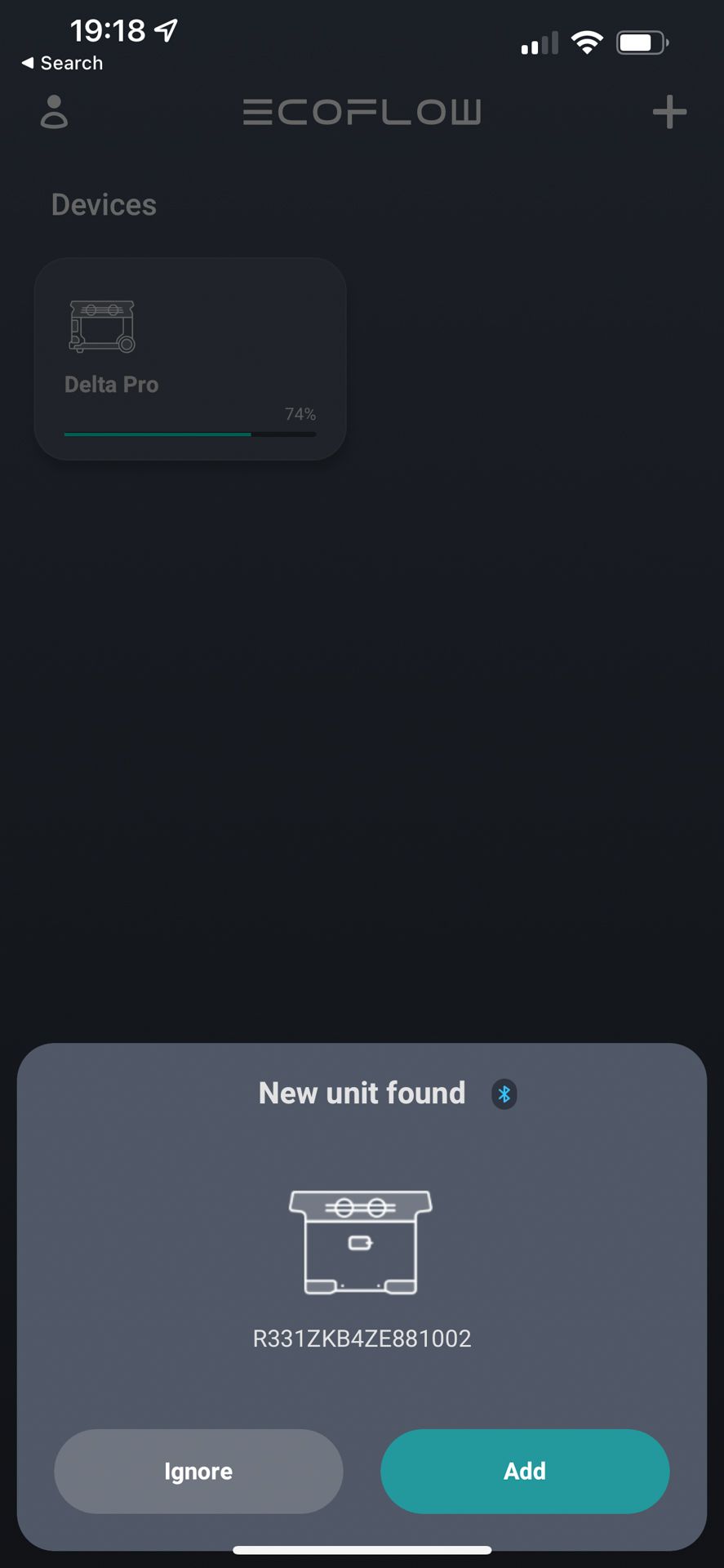
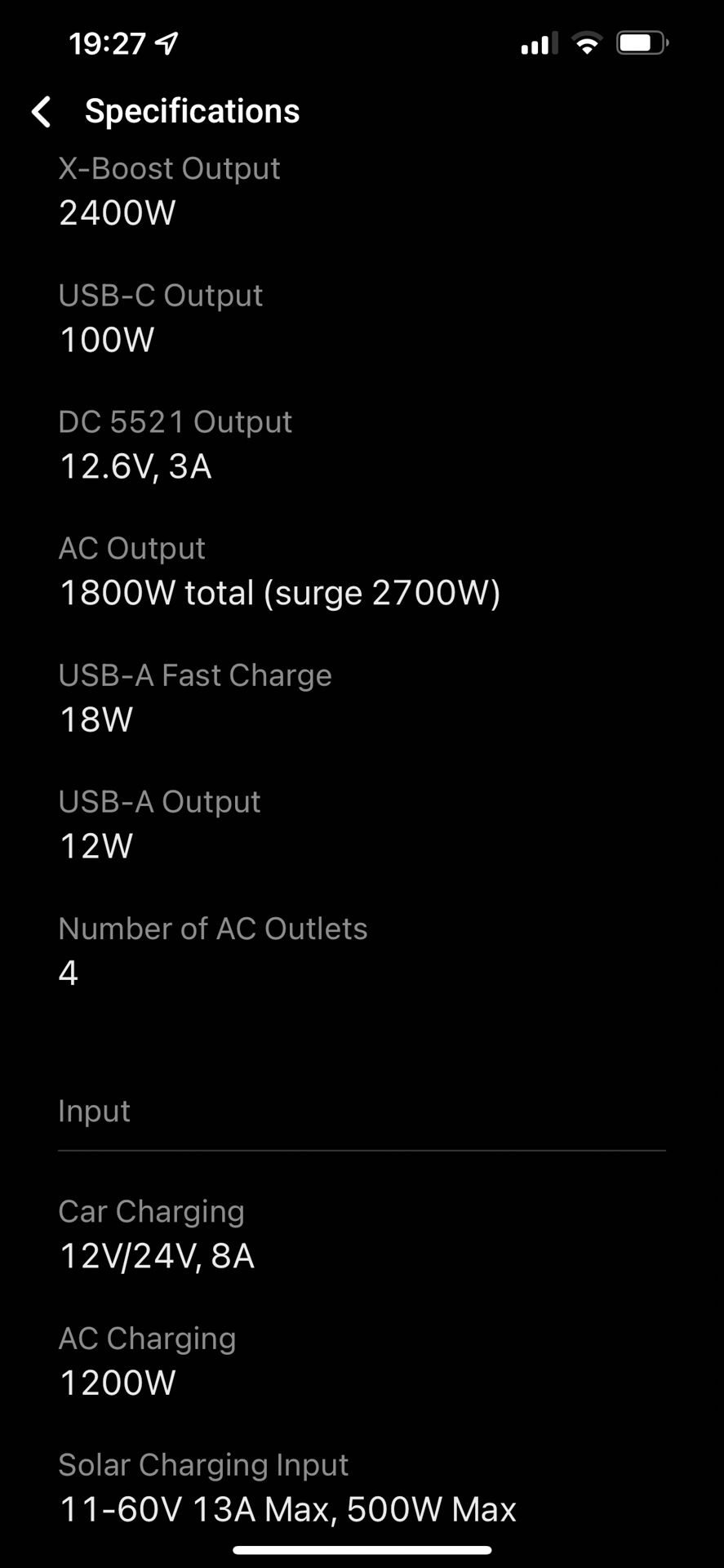
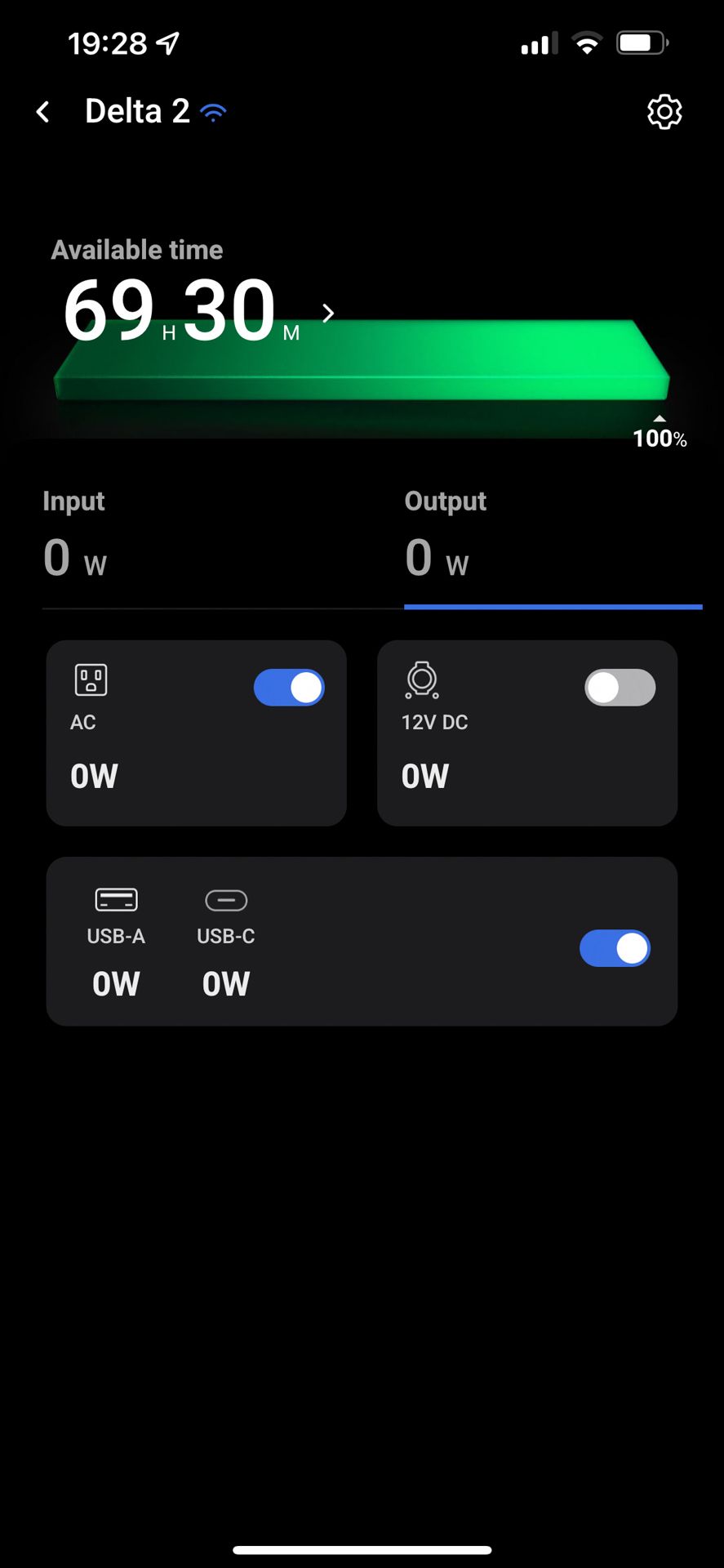
From there, you should connect it to Wi-Fi as well for remote access. The initial connection can only work on 2.4Ghz networks, so if you have a dual-band router on the same network name, try counterintuitively moving away from the router. 2.4Ghz waves penetrate further than the 5Ghz does, so at a certain distance, 5Ghz won't be available. You can then move the battery back anywhere within range and it should connect fine in the future.
Compared to the Delta Pro, the information available within the app for the Delta 2 is far less comprehensive. You get a summary view much the same as the LCD panel, with aggregate totals for the DC, AC, and USB ports. Unlike the Delta Pro, you don't get any pretty graphs, or a breakdown of individual port usage.
The app is also used to configure the AC charge rate, enable XBoost mode, or set the maximum and minimum charge percentage.
So while the app view is simplistic, it is reliable, and quick to refresh. The only thing missing for me is IFTTT or other automation support. It would be nice to have automation abilities if the battery runs low, or even just a notification to say it's full and I should unplug now.
Is This The Best Mid-Capacity Portable Battery Yet?
The Delta 2 is very much a portable high-capacity battery, rather than a hybrid modular whole house system. Depending on your needs, the Delta 2 will be ideal for camping, caravans, or even a small cabin. At $1 per watt-hour, or less if you buy an expansion unit, the price is absolutely reasonable and in line with the competition. However, with the EcoFlow Delta 2, you're getting a longer-lasting product thanks to superior cell technology, not to mention the high output capability and great app.
By comparison, the Jackery Explorer 1000 Pro costs just as much, but only has a rated lifetime of around 1000 cycles due to the use of lithium-ion battery cells, so overall I think the EcoFlow is the better buy.
However, I do think EcoFlow could have leaned into the portability features more. For instance, a camping light would be great. A rugged, dimmable LED on one of the side panels would mean one less gadget to carry. The Delta 2 also lacks wireless charging, which means you had better remember your cables.
Still, if you already have a favorite camping light, and you’d prefer a battery to just be the best battery it can be without added bells and whistles, the Delta 2 is ideal for you.
Delta 2 vs Delta Pro
The Delta 2 can be expanded up to 3kWh if you need to, which is only a little less than the basic Delta Pro (3.6kWh), at roughly the same overall price per watt hour. The Delta 2 and an expansion battery might be more convenient than a single massive battery like the Delta Pro.
As a truly portable device, the maximum solar input of 500W on the Delta 2 is more than enough. However, if you just want some backup power for emergencies at home, the Delta Pro is the better choice. You'll appreciate the higher 1600W max solar input in a grid-down scenario (assuming you have more PV panels to max that out), especially in less sunny countries where every hour of sunshine is a precious commodity. As the famous saying goes... "make hay charge batteries while the sun shines".

